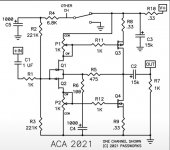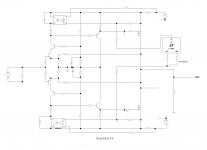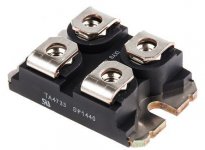What's with the switch to the input bias circuit? A mute switch. It doesn't look like the amp would function with the JFET gates biased near ground.
Nelson said it's the power switch to shut off the Bias to save power. The PS is a switcher and it stays running.
Also, from the discussion afterwards, I got the impression that the Mini ACA is not the new F5, for what it’s worth… 🙂
The thing that interested me was the ability to change R8 and R9 to shift the 2nd harmonic balance. Nelson said he would include these in the Kit.
......
ha!
here it is - unnecessary complicated (so- Babelfish) F5
sole one trimpot for Iq and that's it
though - input JFet pair needs special matching attention
have it filed few years already ..... and it'll stay that way
Because Pa is seldom present at Batsch, ZM goes wild all the year day and night!

ha!
here it is - unnecessary complicated (so- Babelfish) F5
sole one trimpot for Iq and that's it
though - input JFet pair needs special matching attention

have it filed few years already ..... and it'll stay that way
Attachments
Also, from the discussion afterwards, I got the impression that the Mini ACA is not the new F5, for what it’s worth… 🙂
Is this to say that there will also be a new F5 forthcoming, or just to clarify the differences between the new ACA and the F5?
BTW - is this new ACA still running on a 24v outboard PSU? Comparable output power to the original ACA?
Vids are going to be soon at linked Pass ootoobe channel, and all writings will follow kits in Store
Maybe Nelson adds a kind of current source to the F5 similar to Aleph 0.
:--))
In post #6, papa said:
It's going to look like an F5. Just some interesting twists.
He never explained whether both the internal and external appearance would look like an F5.
......
ha!
here it is - unnecessary complicated (so- Babelfish) F5
sole one trimpot for Iq and that's it
though - input JFet pair needs special matching attention
have it filed few years already ..... and it'll stay that way
Why did you file it away? It looks quite plausible for a high power, low distortion F5-like amplifier.
I wrote that before - minute changes of input JFet Idss or, in other words - if we include their source trimpot - minute changes of its position, are making dramatic changes in THD and THD Spectra
so, no way of Damn Greenhorn! making it, without first obtaining some hardware and learning how to use it, for setting THD Spectra of an amp
it seems Papa spoiled even me , of lately, tending to make more and more simpler Babelfishes

(No way, Jose! ZM is Omnicomplicator)
so, no way of Damn Greenhorn! making it, without first obtaining some hardware and learning how to use it, for setting THD Spectra of an amp
it seems Papa spoiled even me , of lately, tending to make more and more simpler Babelfishes

(No way, Jose! ZM is Omnicomplicator)
lhquam - A parallel output device (even just 2 pair) F5 with cascode front-end and P3, running at 35-40V rails would be an excellent higher-power, low-distortion amp. Basically a F5T “1.5” because no diodes.
ZM: That makes sense:
The source trimpot in the original F5 modified the open-loop gain balance between the upper and lower halves.
Your Babelfish F5 eliminates degeneration of the output FETs and greatly increases the open-loop gain, thus magnifying the effect of the source trimpot.
This problem probably goes away if the F5 style feedback is replaced by one simple voltage divider to the JFET source pins, with or without the trimpot. But, then the amplifier is no longer has the unique characteristic of the F5.
Yes, with the Babelfish F5 emitter followers driving the gates of the output FETs, hocky puck input capacitances should be easy to drive.
The source trimpot in the original F5 modified the open-loop gain balance between the upper and lower halves.
Your Babelfish F5 eliminates degeneration of the output FETs and greatly increases the open-loop gain, thus magnifying the effect of the source trimpot.
This problem probably goes away if the F5 style feedback is replaced by one simple voltage divider to the JFET source pins, with or without the trimpot. But, then the amplifier is no longer has the unique characteristic of the F5.
Yes, with the Babelfish F5 emitter followers driving the gates of the output FETs, hocky puck input capacitances should be easy to drive.
What are "pucks"?
more of ZM 😉
pucks are hockey pucks are IXYS outputs in very XA25
for example see picture (IXYS IXFN):
Attachments
- Home
- Amplifiers
- Pass Labs
- Update on Pa's new F5?




